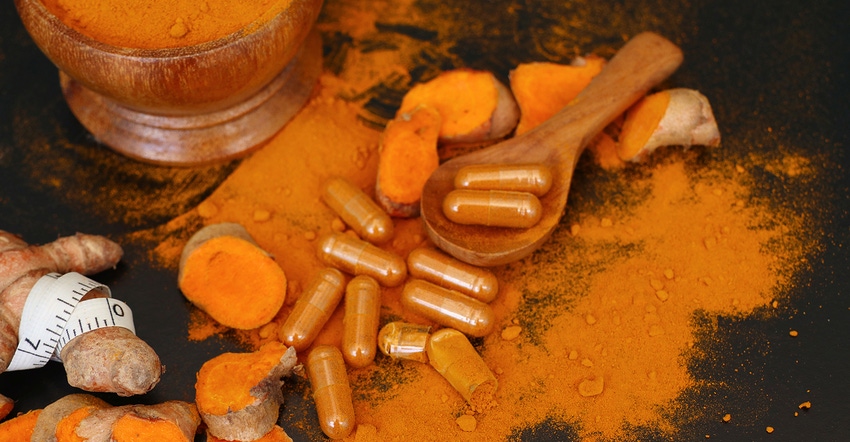The fast growth of curcumin’s popularity means sales opportunity for supplement brands, but consumers are often confused by its bioavailability and sourcing issues.

Turmeric is one of the most popular and well-known ingredients in both the natural marketplace and mainstream media.
For five consecutive years, turmeric has continued to be the top-selling herbal supplement in the natural products channel with sales just over US$50 million in 2017, up 12.2 percent from the previous year, according to figures from a September 2018 report from the American Botanical Council’s (ABC) HerbalGram. Mainstream consumers are also increasing their purchases of turmeric supplements with $32.45 million spent in 2017, making it the fifth best-selling ingredient in this channel. In addition, turmeric was classified as the “breakout star” of the functional food movement due to its 300 percent increase in Google searches from 2011 to 2016.
Turmeric consumer interest is rising in North America—which in 2016, was the largest regional market to purchase curcumin—in turmeric and curcumin condition-specific supplements, particularly in the arena of joint health, inflammation, immune health and pain, according to Research and Markets. And Europe is expected to be the next fastest growing region due to buyer demands and regulatory support from the European Food Safety Association (EFSA)..
These growth projections and statistics show that turmeric is a consumer favorite most likely because of the numerous health benefits and the popularity of “wellness tonics,” as noted in the HerbalGram report. This is a critical time for suppliers and distributors to pay close attention and educate not only themselves, but also the end consumer, on the recent research of turmeric and curcumin’s health benefits. It is vital that we all understand the adulteration, potency and the bioavailability issues that come along with turmeric and curcumin.
The researched benefits of curcumin are vast, and many studies show that this ancient Ayurvedic ingredient has numerous therapeutic benefits that aid in the management of oxidative and inflammatory conditions, metabolic syndrome, joint health and brain health (Foods. 2017 Oct; 6(10): 92). However, with as many health benefits as this ingredient has demonstrated, its popularity may have led to misunderstanding or confusion amongst customers.
In 2008, turmeric had only about 200 published studies and curcumin had just over 500 published studies on the National Institutes of Health’s (NIH) U.S. National Library of Medicine (PubMed.gov). Fast forward 11 years and PubMed has nearly 5,000 published studies on turmeric and more than 12,700 published research articles on curcumin. With the exponential growth in popularity, it is no wonder why some consumers are confused. Specifically, some need to better understand the differences between turmeric and curcumin, and they need more education on the ingredient’s bioavailability and excipient concerns.
Curcumin is the main active ingredient in turmeric and has a long history of use in the traditional medicine systems of India (Ayurveda) and China (Cell Mol Life Sci. 2008 Jun; 65(11): 1631–1652.) Although turmeric and curcumin have been shown to have positive health benefits, they are different, and consumers need to better understand those differences.
The supplement industry can better market bioavailability, but one of the biggest challenges in bioavailability marketing is consumer confusion about the relative bioavailability of certain ingredients. For example, “XXX times” compared to “XX+1” times is confusing and meaningless to consumers. A better way to show the absolute measure of how much an active ingredient is absorbed in the body is to compare the number of curcuminoids per mL of blood plasma. This absolute measure is more meaningful than comparing "XX" times absorption.
Excipients are ingredients used in delivery systems to help enhance an ingredient’s bioavailability. When curcumin is delivered orally, it is difficult for the body to absorb a high, therapeutic dose (Eur J Nutr. 2018 Jul 4) which is why in the past, some organizations have conducted clinical studies on adding other ingredients such as black pepper to help with absorption issues (Foods. 2017 Oct; 6(10): 92). Recent research has shown positive effects with technologies tailored to increase the dispersion of crystalline lipophilic agents in aqueous environments and enhance absorption. Furtherm these studies have shown such ingredients deliver higher plasma curcuminoid concentrations and significant bioavailability (Eur J Nutr. 2018 Jul 4).
The supplement industry needs to continue to conduct these types of clinical studies to educate itself and the mainstream media on how we can better take advantage of this powerful ingredient.
Standing out in a Sea of Orange
Amazon has more than 2,000 finished turmeric and curcumin products. To have a product stand out, a brand can:
Ensure supply chain transparency for the most potent and unadulterated ingredient (some ingredient distributors take this task on for brands)
Review what is in the final product and confirm that there is a small percentage of additives or excipients
Ensure the finished product contains the highest therapeutic dose of curcumin or turmeric as per recommended in the clinical trials
Develop a clinically tested finished product that combines multiple ingredients that work on separate pathways within the body.
American consumers are looking for curcumin condition-specific supplements and offering a product like this could allow manufacturers the opportunity to create specific and personalized supplementation options with synergistic effects that consumers will crave.
Chase Shryoc is vice president of sales and business development at Gencor.
About the Author(s)
You May Also Like






.png?width=800&auto=webp&quality=80&disable=upscale)